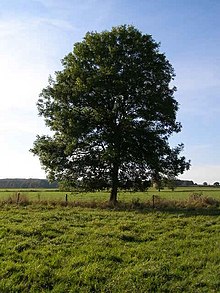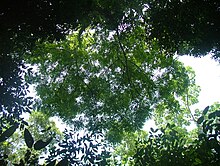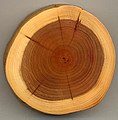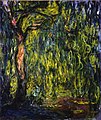Portal:Trees
The Trees Portal

In botany, a tree is a perennial plant with an elongated stem, or trunk, usually supporting branches and leaves. In some usages, the definition of a tree may be narrower, including only woody plants with secondary growth, plants that are usable as lumber or plants above a specified height. In wider definitions, the taller palms, tree ferns, bananas, and bamboos are also trees.
Trees are not a monophyletic taxonomic group but consist of a wide variety of plant species that have independently evolved a trunk and branches as a way to tower above other plants to compete for sunlight. The majority of tree species are angiosperms or hardwoods; of the rest, many are gymnosperms or softwoods. Trees tend to be long-lived, some reaching several thousand years old. Trees have been in existence for 370 million years. It is estimated that there are around three trillion mature trees in the world.
A tree typically has many secondary branches supported clear of the ground by the trunk, which typically contains woody tissue for strength, and vascular tissue to carry materials from one part of the tree to another. For most trees it is surrounded by a layer of bark which serves as a protective barrier. Below the ground, the roots branch and spread out widely; they serve to anchor the tree and extract moisture and nutrients from the soil. Above ground, the branches divide into smaller branches and shoots. The shoots typically bear leaves, which capture light energy and convert it into sugars by photosynthesis, providing the food for the tree's growth and development.
Trees usually reproduce using seeds. Flowers and fruit may be present, but some trees, such as conifers, instead have pollen cones and seed cones. Palms, bananas, and bamboos also produce seeds, but tree ferns produce spores instead.
Trees play a significant role in reducing erosion and moderating the climate. They remove carbon dioxide from the atmosphere and store large quantities of carbon in their tissues. Trees and forests provide a habitat for many species of animals and plants. Tropical rainforests are among the most biodiverse habitats in the world. Trees provide shade and shelter, timber for construction, fuel for cooking and heating, and fruit for food as well as having many other uses. In much of the world, forests are shrinking as trees are cleared to increase the amount of land available for agriculture. Because of their longevity and usefulness, trees have always been revered, with sacred groves in various cultures, and they play a role in many of the world's mythologies. (Full article...)
Simarouba amara is a species of tree in the family Simaroubaceae, found in the rainforests and savannahs of South and Central America and the Caribbean. It was first described by Aubl. in French Guiana in 1775 and is one of six species of Simarouba. The tree is evergreen, but produces a new set of leaves once a year. It requires relatively high levels of light to grow and grows rapidly in these conditions, but lives for a relatively short time. In Panama, it flowers during the dry season in February and March, whereas in Costa Rica, where there is no dry season it flowers later, between March and July. As the species is dioecious, the trees are either male or female and only produce male or female flowers. The small yellow flowers are thought to be pollinated by insects, the resulting fruits are dispersed by animals including monkeys, birds and fruit-eating bats and the seeds are also dispersed by leaf cutter ants.
Simarouba amara has been studied extensively by scientists in an attempt to understand the tree and also to gain a better understanding of the ecology of the rainforest in general. Many of these studies were conducted on Barro Colorado Island in Panama or at La Selva Biological Station in Costa Rica. Of particular interest is how it competes with other species and with individuals of the same species at different stages in its life cycle. The seedlings are normally limited by the amount of light and nutrients found where they are growing and the saplings are considered relatively light demanding compared to other species. Young individuals are more likely to survive when they grow further away from their parents and when there are few other individuals growing near to them, which may be due to them being able to escape diseases. Plant physiologists have investigated how the leaves of the tree differ depending on their location in the forest canopy finding they are thicker in the canopy and thinner in the understory. They have also measured how the water potential of their leaves changes and when their stomata open and close during the day; the findings suggest that rather than closing their stomata to control water loss, it is controlled by the leaf area instead. Population geneticists have examined the way in which its genes vary, at both the local scale and across its range using microsatellites. It is genetically diverse, indicating gene flow occurs between populations and seeds can be dispersed up to 1 km. The leaves of S. amara are eaten by several species of caterpillar, particularly those in the genus Atteva. Several species of termite and ants live on or around the tree and lianas and epiphytes grow on the tree. (Full article...)Did you know? -
- ... that the Top 10 New Species of the past year include a 40 foot (12 m) tall tree (pictured), a crustacean that looks like a skeleton, a protist that acts like a sponge, and a fungus named after the King of the Netherlands?
- ... that the Pass Christian Light was deactivated in part because neighboring property owners refused to trim their trees?
- ... that Cossinia trifoliata trees endemic to New Caledonia have become vulnerable to extinction, according to the International Union for Conservation of Nature's 1998 assessment?
- ... that the Hanlon Expressway is named after Felix Hanlon, who helped cut the first tree to inaugurate Guelph, Ontario?
- ... that British architect Richard Feilden was killed by a falling tree whilst creating a woodland memorial for his recently deceased father?
- ... that according to tradition the Church of the Holy Archangels, Rogoz was built from two huge elm trees?
- ... that the oak tree under which Goethe allegedly wrote Faust's Walpurgis Night scene stood inside Buchenwald concentration camp and was sketched by French Volontaires de la Liberté member and camp inmate Léon Delarbre?
Selected article -
Adansonia is a genus made up of eight species of medium-to-large deciduous trees known as baobabs (/ˈbaʊbæb/ or /ˈbeɪoʊbæb/) or adansonias. They are placed in the Malvaceae family, subfamily Bombacoideae. They are native to Madagascar, mainland Africa, and Australia. The trees have also been introduced to other regions such as Asia. A genomic and ecological analysis has suggested that the genus is Madagascan in origin.
The generic name honours Michel Adanson, the French naturalist and explorer who described Adansonia digitata. The baobab is also known as the "upside down tree", a name that originates from several myths. They are among the most long-lived of vascular plants and have large flowers that are reproductive for a maximum of 15 hours. The flowers open around dusk, opening so quickly that movement can be detected by the naked eye, and are faded by the next morning. The fruits are large, oval to round and berry-like and hold kidney-shaped seeds in a dry, pulpy matrix. (Full article...)General images
Selected lists
Subcategories
Related portals
Associated Wikimedia
The following Wikimedia Foundation sister projects provide more on this subject:
-
Commons
Free media repository -
Wikibooks
Free textbooks and manuals -
Wikidata
Free knowledge base -
Wikinews
Free-content news -
Wikiquote
Collection of quotations -
Wikisource
Free-content library -
Wikispecies
Directory of species -
Wikiversity
Free learning tools -
Wiktionary
Dictionary and thesaurus
















































































